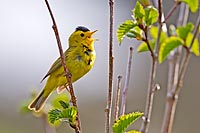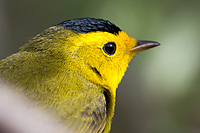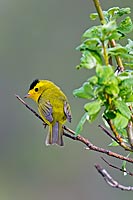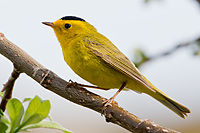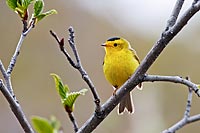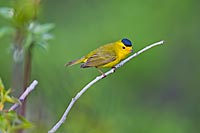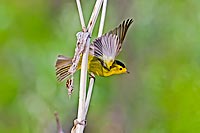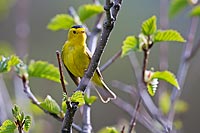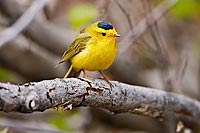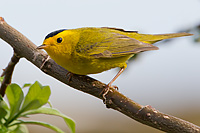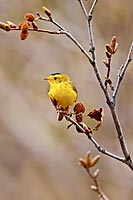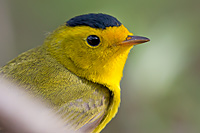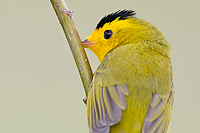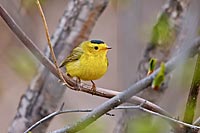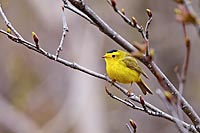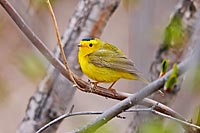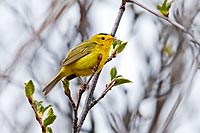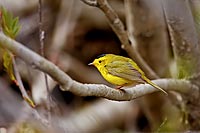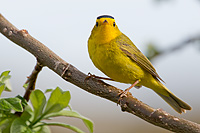 |
~ Wilson's Warblers in Alaska ~
| |
|
|
|
Wilson's Warblers are fairly small songbirds that can often be found in willows and other types of bushes in Alaska.
They take their name after Alexander Wilson who studied and described that bird species. They have a distinctive bright yellow under-belly, and
olive green plumage on the wings and back side. Males have a black cap on the top of their head, in contrast to a more uniform green color scheme for the females.
|
|
|
In spite of their tiny size of roughly 4 inches from the tip of the
beak to the tail feathers, Wilson's Warblers are able to complete an impressive migration every year.
They winter in Central America and migrate north to Alaska and Canada for the breeding season.
|
|
|
|
|
|
|
Common Names:
Scientific Name:
|
Wilson's Warbler
Cardellina pusilla
|
Class:
Family:
|
Aves
Parulidae
|
Breeding Range:
Winter Range:
|
Alaska, Canada
Central America
|
Length:
Weight:
|
10 to 12 cm
5 to 10 grams
|
| |
Due to their small size, taking pictures of the Wilson's Warbler is quite a challenge for bird photographers. To make things even more difficult, they
are extremely fast and don't stay put for very long.
|
|
|
Wilson's Warbler Migration & Habitat |
|
|
From November to February, the Wilson's Warbler enjoys the wintering grounds of Central America, such as the coffee plantations of southern Mexico.
As early as March, they begin their annual migration north to their breeding range in Alaska, Canada or the Pacific North West,
a journey that can surpass 4500 miles one way.
They take advantage of the warm summer months to raise their brood of usually 4 to 5 chicks.
|
|
|
|
|
|
|
|
|
Wilson's Warblers build their nest on the ground where they lay brown spotted eggs. Most Wilson's Warblers will start their migration south in September.
|
|
|
|
|
This small bird's diet mostly consists of insects and sometimes wild berries. They usually forage through small shrubs where they actually find themselves
comfortable since it provides them with protection and food at the same time.
|
|
|
|
|
Wilson's Warbler
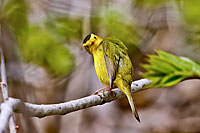 |
|
|
|
|
|
Among insects, they often dine on beetles and small carterpillars that they pluck from shrubs, but they are also seen capturing insects in flight. It
is not uncommon to see a small flock of Wilson's Warblers flying back and forth. They remain very active throughout the day.
|
|
|
|
|
|
Wilson's Warbler Feather Details |
|
|
|
|
This tiny bird has a beautiful plumage. The bright yellow underbelly is complemented with the distrintive olive green color on head and back side. The
wings and tail have long feathers of a purplish hue, as seen in this extreme close up picture of the feather details. This picture gives us an new appreciation
of the intricate feather pattern on the back and wings of the Wilson's Warbler.
|
|
|
In addition, its extremely small size makes it difficult to actually see all
the details as it flies by you.
|
|
|
|
Male Wilson's Warbler Feather Detail
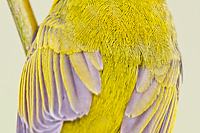 |
|
|
|
Wilson's Warbler in South Central Alaska |
|
|
These picures of Wilson's Warblers are taken in South Central Alaska during the summer. Male specimen with the distinctive black crown on the head.
|
|
|
|
|
Male Wilson's Warbler
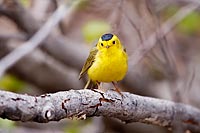 |
|
|
|
|
|
|
|
You have to be quick in order to photograph these tiny birds. They land in front of you and take off in the blink of an eye...
|
|
Go to the Moon & Get the Best Pictures
...Smile... ' Click! '

[email protected]
© Copyright Go2Moon, Alaska


